This post may contain affiliate links. Please read our disclosure policy.
Today’s recipe features a roasted Peruvian chicken using a marinade with bold flavors to infuse the chicken with a rich taste. The marinated chicken is spatchcocked and roasted in the oven, resulting in crispy spiced skin and juicy meat. It is served with a spicy Aji verde sauce, very popular in Peru. If you’re looking for a delicious new way to roast a chicken, give this Peruvian-style roast chicken a try!
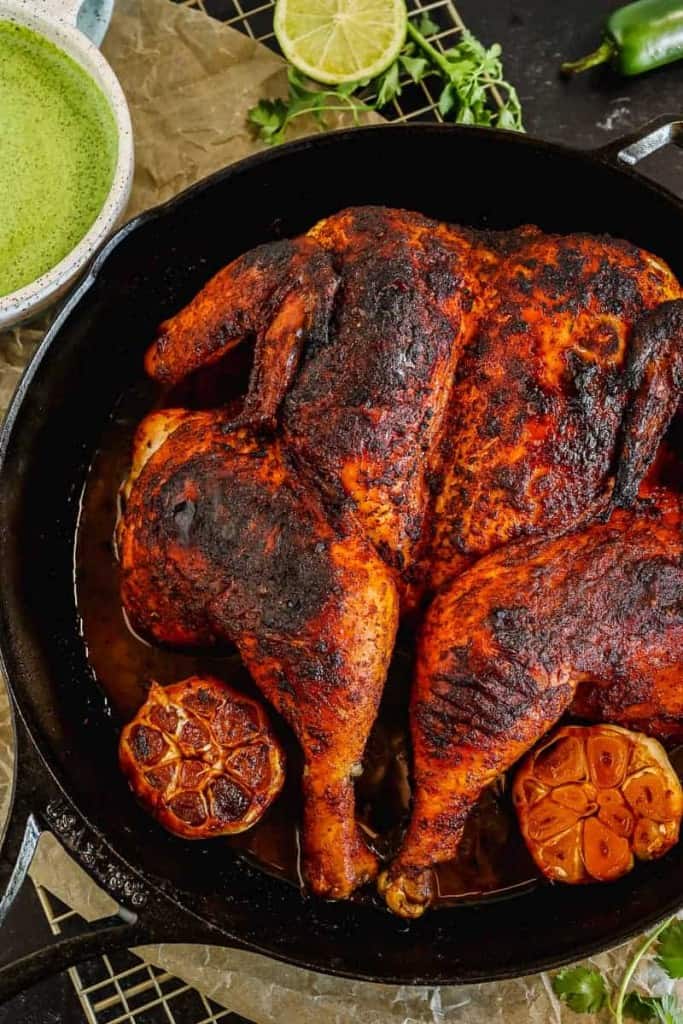
What is Peruvian chicken?
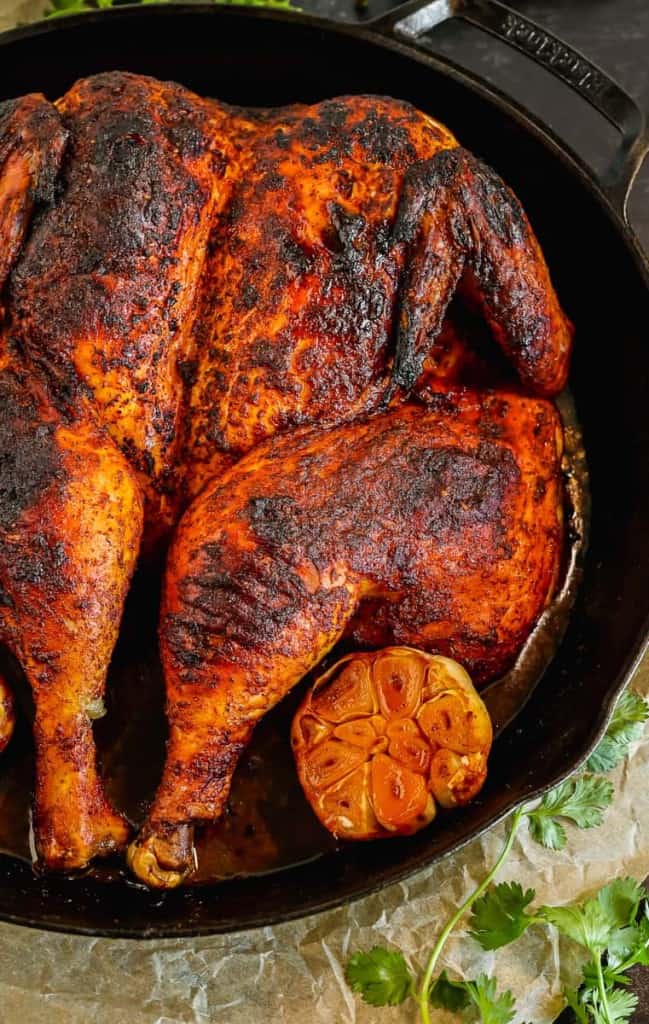
Email this Recipe!
Email this recipe to yourself to save for later.
By submitting this form, you agree to receive emails from Girl with the Iron Cast.
Peruvian chicken, also called pollo la brasa, is a type of rotisserie chicken that comes from Lima, Peru. It is traditionally cooked on a charcoal rotisserie (cooked over hot coals while rotating) and seasoned with several herbs, spices, and oils.
The end result is a juicy, crispy-skinned chicken that has amazing flavor!
Its popularity led to the creation of a special day to celebrate it on July 21st. That’s how good it is!
My version of this recipe is modified to be roasted in the oven, which, in my opinion, is so much easier to make. And it tastes just as delicious!
Why spatchcock a chicken?
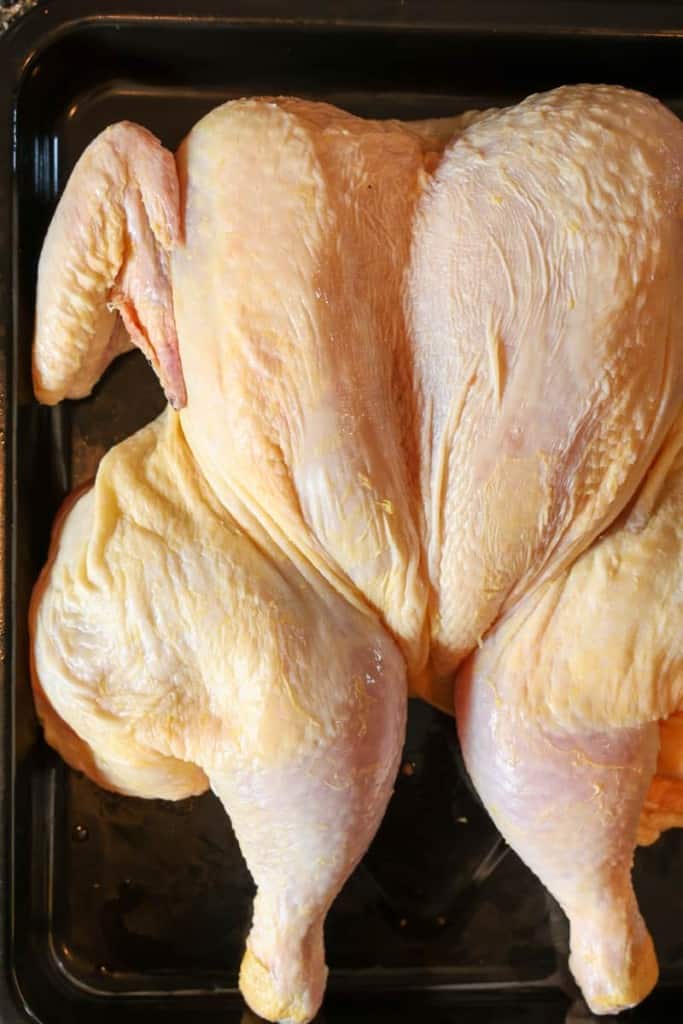
Spatchcocking a chicken can make it easier to cook evenly!
When you roast a whole chicken, some parts may cook faster than others. As a result, the breast may become dry while the legs are still undercooked.
By spatchcocking the chicken, you can lay it flat with the breast and legs at the same level. This allows the chicken to cook evenly, resulting in a more delicious meal.
Plus, the spatchcocking method can also create crispy and flavorful skin since the surface area of the chicken is evenly exposed to the heat!
Ingredients needed
Here’s everything you need to make this juicy Peruvian chicken recipe…
- Whole chicken
Marinade
- Dark brown sugar
- Chili powder
- Smoked paprika
- Ground cumin
- Garlic cloves and garlic heads
- Ground ginger
- Low-sodium soy sauce
- Lime juice
- Lime zest
- Olive oil
- Kosher salt
Aji verde (green sauce)
- Cilantro
- Mayo
- Cotija cheese
- Jalapeños
- Garlic cloves
- Avocado oil (or olive oil)
- Lime
- Kosher salt
How to prep a whole chicken
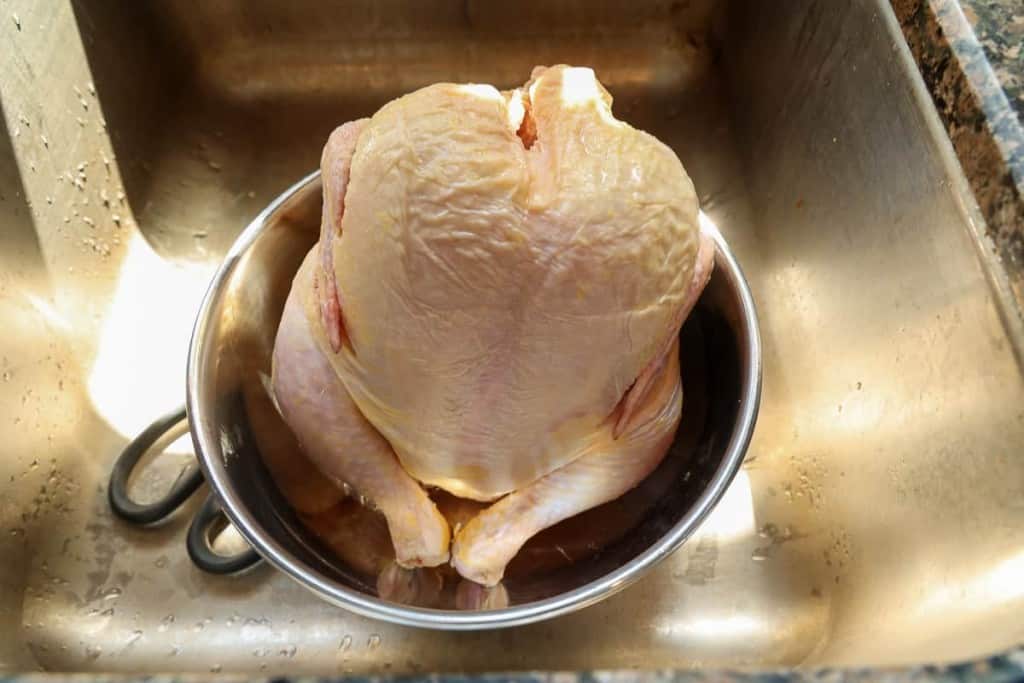
When handling chicken, I like to wear gloves and also set up a sanitary station with a bowl, sheet pan, and a gallon food storage bag for throwing away the trash.
To prep the chicken:
- Take out the bag from inside the chicken and the pouch near its neck. I typically like to freeze it until it’s time to throw it away on garbage day.
- After that, use a colander over a bowl to collect the juices and dry the chicken with paper towels.
- Put the used paper towels in a separate bag, and don’t touch anything else without gloves or washing your hands.
Tip:
Make sure to dry the whole chicken, including the cavity!
Could I buy a whole chicken that is already prepped for cooking?
Yes! You can usually find pre-trimmed, already-cleaned whole chickens at the grocery store. This makes your life a lot easier as they are already ready to use for cooking!
How to spatchcock a chicken
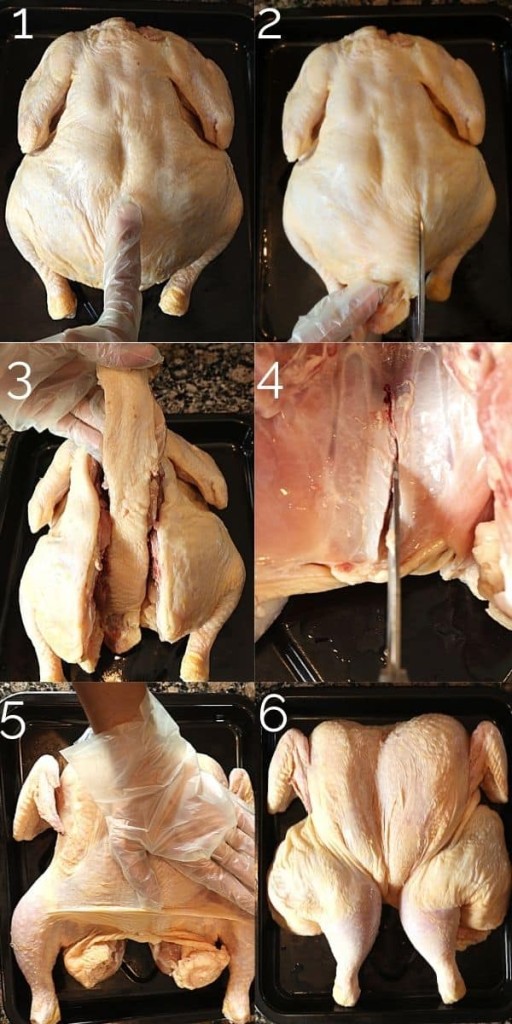
Once the chicken is prepped, transfer it to the sheet pan, breast side down.
This is how you spatchcock a chicken before roasting:
- Locate the backbone of the chicken.
- Using sharp poultry shears (or strong scissors), begin cutting to one side of the backbone. There are small bones you will be cutting, though, so ensure the scissors are strong enough.
- Repeat on the other side of the backbone and then place the backbone in the storage discard bag.
- Next, locate the inside of the breast bone. Be careful to not cut the skin! You want to cut through the cartilage of the breast bone. This will help when you need to flatten the breast.
- Flip the chicken over and place the heel of your hand in the middle of the breast. Press down hard until the breast is fully flattened.
- Rotate the legs inward.
Tip:
You can also tuck the wings into the armpits, so the tips do not burn when roasting!
Do I need to tie the chicken?
No need to tie the chicken! The spatchcocking technique is used to flatten the chicken, so it cooks evenly. That’s why you don’t need to worry about tying up the legs or wings.
How to make the Peruvian chicken marinade
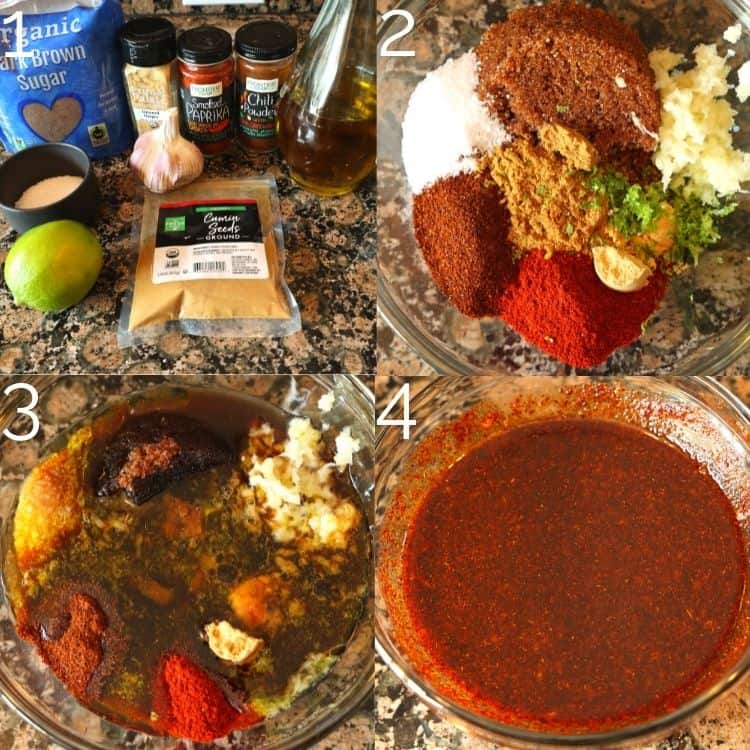
Making the marinade is super simple!
In a large bowl, combine dark brown sugar, chili powder, smoked paprika, ground cumin, garlic cloves and garlic heads (minced or grated), ground ginger, low-sodium soy sauce, lime juice, and zest.
Mix all ingredients together and then add some olive oil until everything is combined. Lastly, add some kosher salt.
Add marinade to chicken
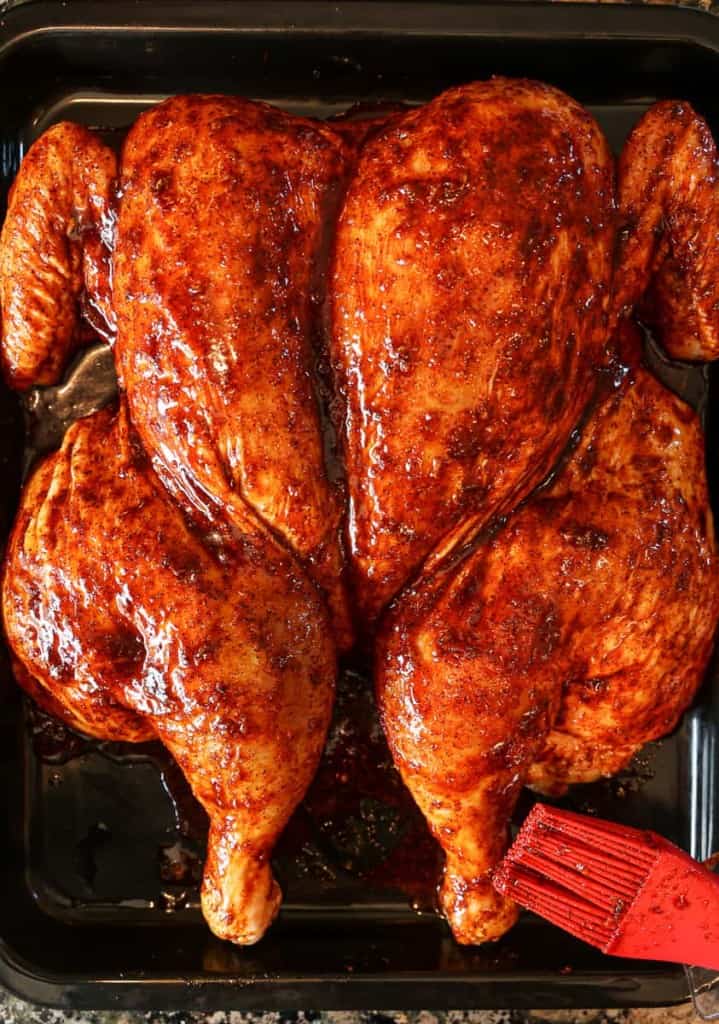
To maximize the flavor, use a marinade brush to brush the entire surface of the chicken, making sure to get into all the nooks and crannies. Afterward, refrigerate the chicken overnight to marinate.
Do I need to marinate it overnight?
Yes, if you have the time, marinating it overnight is best! The longer it sits in the marinade, the more flavor will be absorbed.
Roast the chicken in the oven
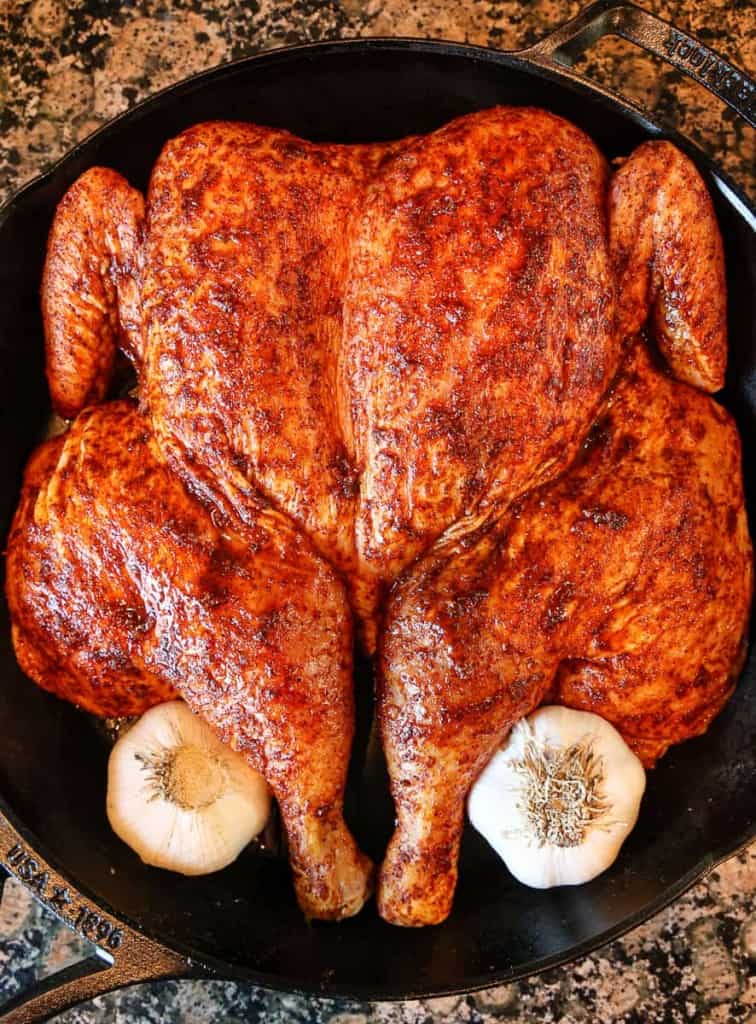
Okay, we are back, and it’s the next day. Now, it’s time to roast the chicken!
There are 2 ways you can roast the chicken:
- Sheet pan
- Cast iron skillet
I personally prefer roasting in my cast iron pan to keep the heat evenly throughout the skillet. If you can’t tell, it’s my go-to kitchen tool! LOL
To start:
- Preheat oven to 425°F.
- Take two heads of garlic and cut the top 1/4 off to expose the bulbs.
- Tuck these cut sides down next to the legs.
- Place in the oven.
Tip:
A thermometer will be your best friend in this recipe! You are looking for an internal temperature of 165°F. Make sure to test the thickest part of the breast and also the leg before removing it from the oven.
Once the internal temperature of the chicken reaches 165F, remove it from the oven. I love using oven-safe thermometer probes, so you don’t have to keep pulling the chicken out to check on the temperature.
My chicken skin is burning, but it’s not cooked through – HELP!
If the skin begins charring too much for your liking, you can tent it with foil to keep the skin from burning.
How long will my Peruvian chicken take to cook?
Depending on the size of your bird, it should take about 45 minutes.
Make the aji verde
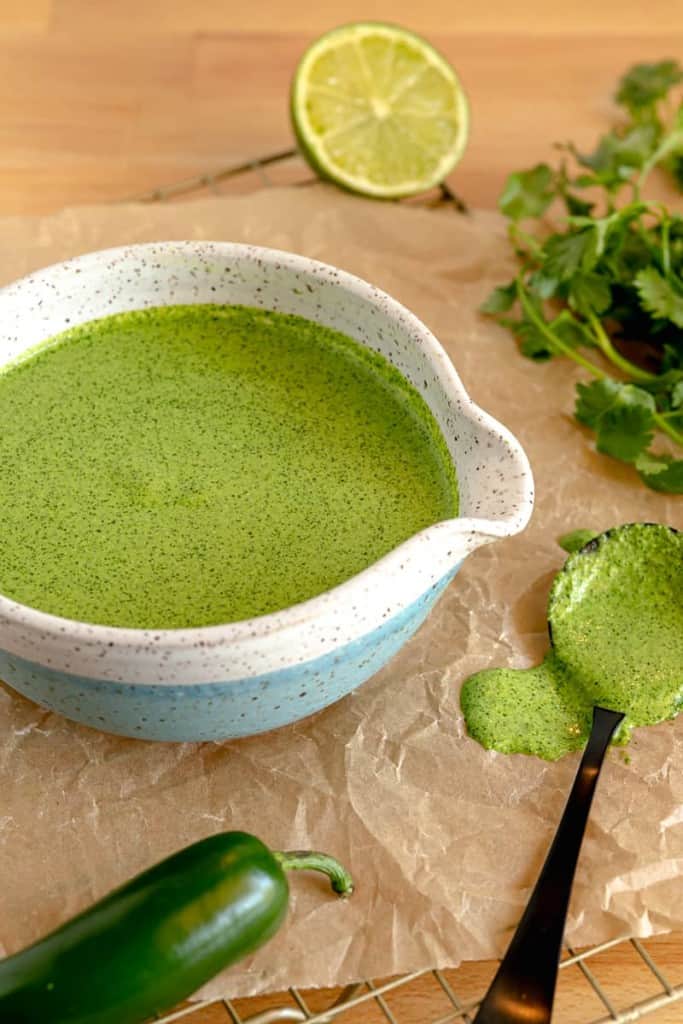
While the chicken is roasting, this is the perfect opportunity to make the Peruvian chicken sauce, a.k.a. aji verde!
Aji verde is a spicy Peruvian green sauce with notable ingredients of aji chile peppers, huacatay leaves (black mint), and cheese.
Tip:
Since aji chiles are hard to find, you can substitute Serrano or jalapeño peppers. Huacatay also can be hard to find, so cilantro is used instead!
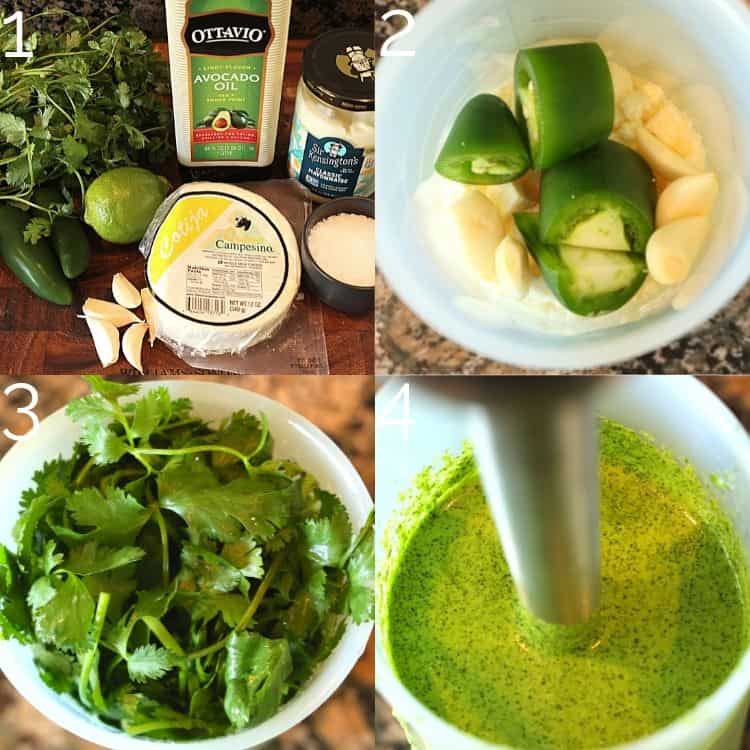
To make the green sauce:
- Using a food processor or an immersion blender, blend cilantro, peppers, lime juice, garlic, cotija cheese, mayo, and salt.
This aji verde sauce is served alongside pollo a la brasa, but is amazing on fish, steak, potatoes, and anything you can think of. A sauce that you will want to put on everything!
Tip:
The cotija is salty, so it’s best to blend and adjust the salt after tasting.
Can I make this aji verde not spicy?
Absolutely! If you are looking to make this sauce mild, reduce the amount of jalapeño peppers added.
What other cheese can I use?
If you can’t find cotija cheese, queso fresco or feta are excellent substitutes.
How to serve
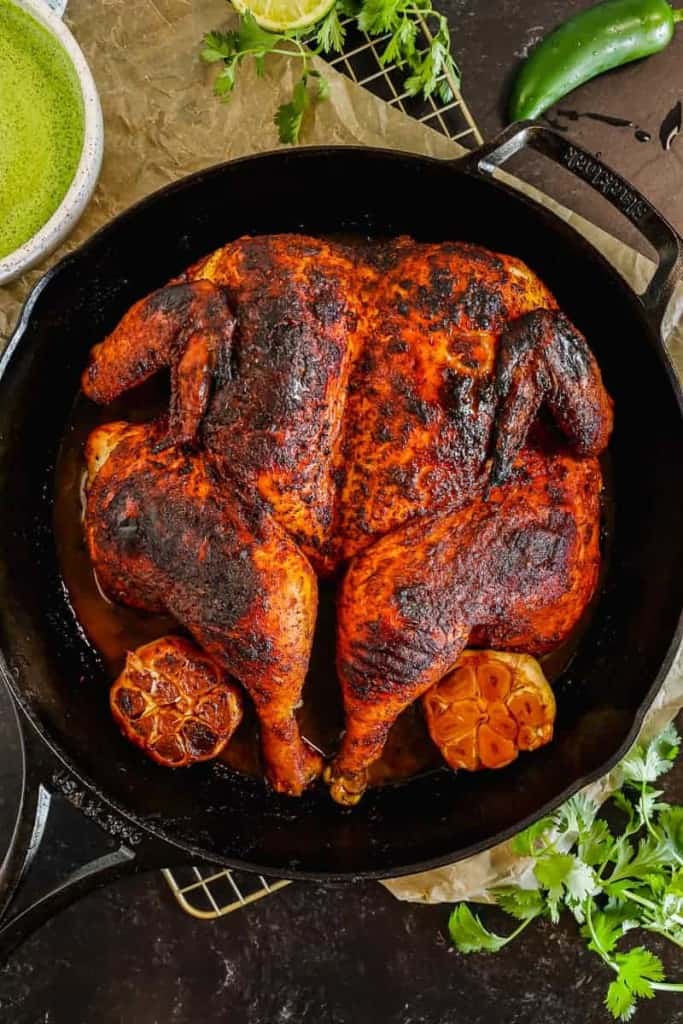
Once your Peruvian roast chicken is fully cooked and removed from the oven, let it rest for about 10 minutes before cutting into it.
To remove the legs from the chicken, lift by the bone to expose where the leg meets the breast and cut through where the thigh meets the breast. To separate the leg from the thigh, cut through the joint.
Slice the breast down the middle, and you can additionally cut it into slices to serve.
The rest of the bones can be discarded in a food storage bag and frozen until trash day.
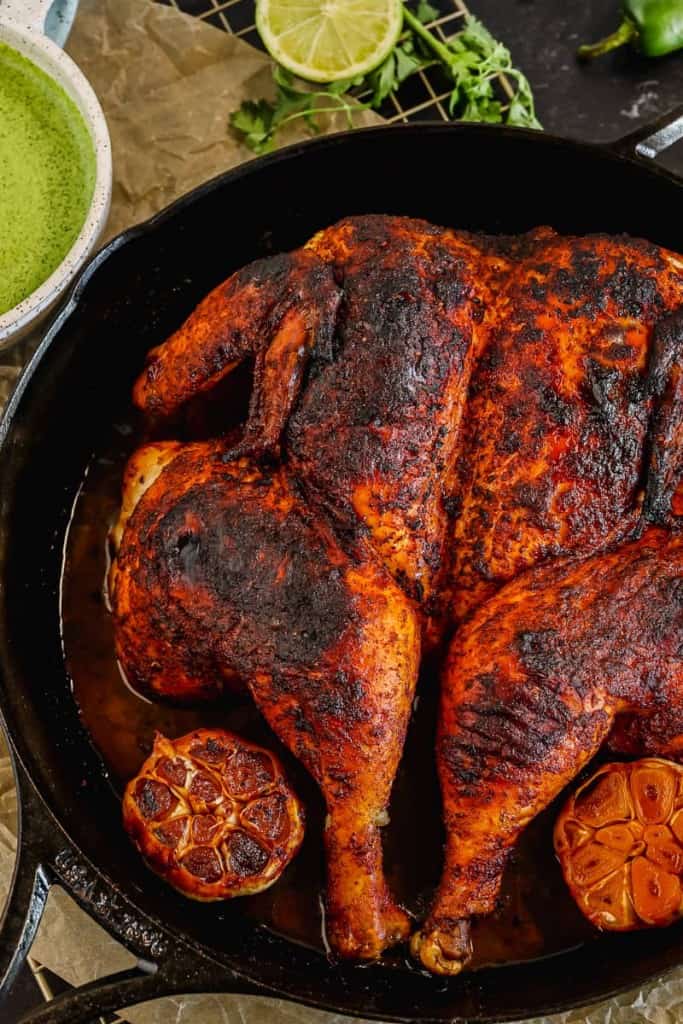
How to eat
Whenever I make this Peruvian chicken, I like to eat it with a spoonful of fresh aji verde and roasted caramelized garlic from the pan.
As a side dish, I’ll usually make crispy tostones or yucca fries to dip into the sauce. Or, I’ll warm up some fresh tortillas on the cast iron skillet and make some tacos. For some veggies, I like to pair this Peruvian chicken recipe with some asparagus or roasted sweet potatoes.
So finger-licking good – This dinner is always a hit with my family and friends!
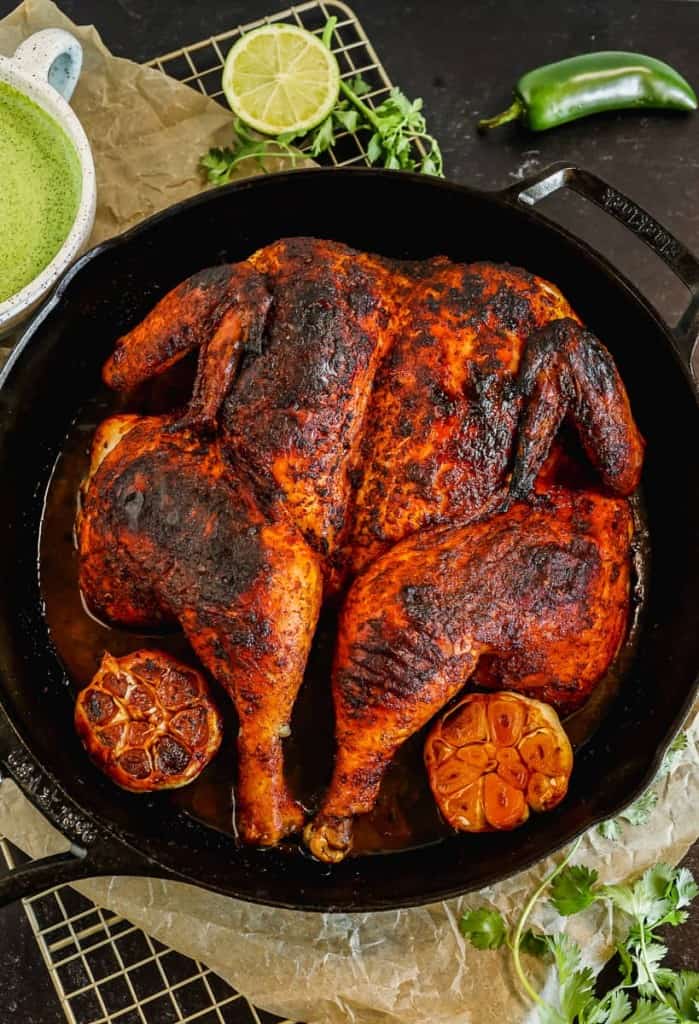
How do I store this chicken for later?
The best way to store roasted chicken is to let it cool completely before placing it in the fridge. Place the cooked Peruvian chicken into a large airtight container or wrap it in plastic wrap and place it in a food-safe bag.
When stored properly, your leftovers will last for up to four days in the refrigerator. You can also freeze this chicken for up to three months. However, the texture of the skin and meat may change slightly after being frozen.
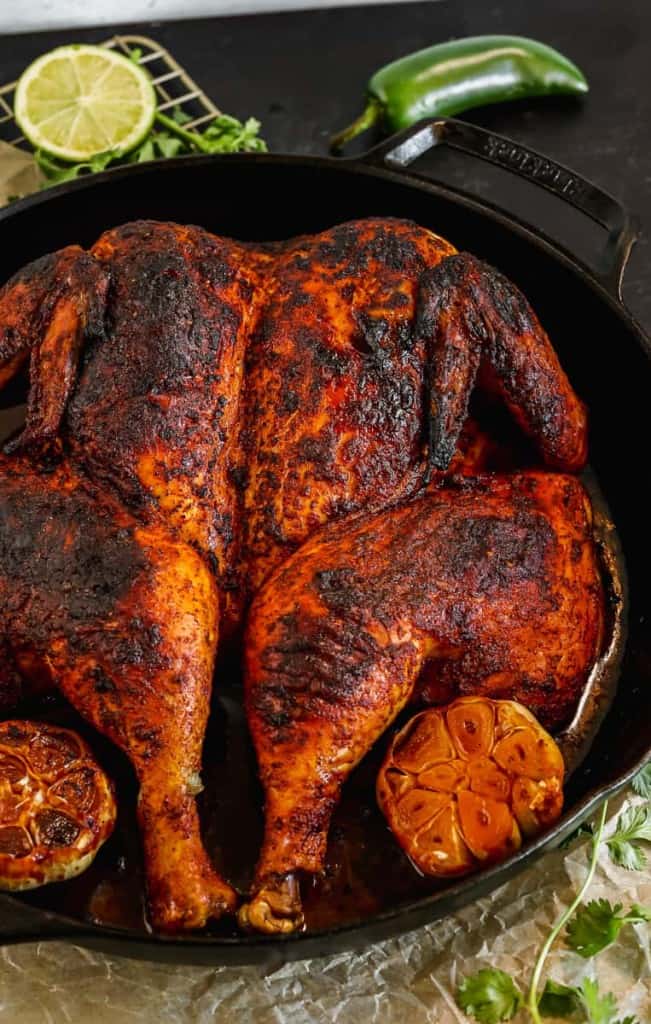
Love chicken? Try out these recipes
For the web story version of this recipe, click here!
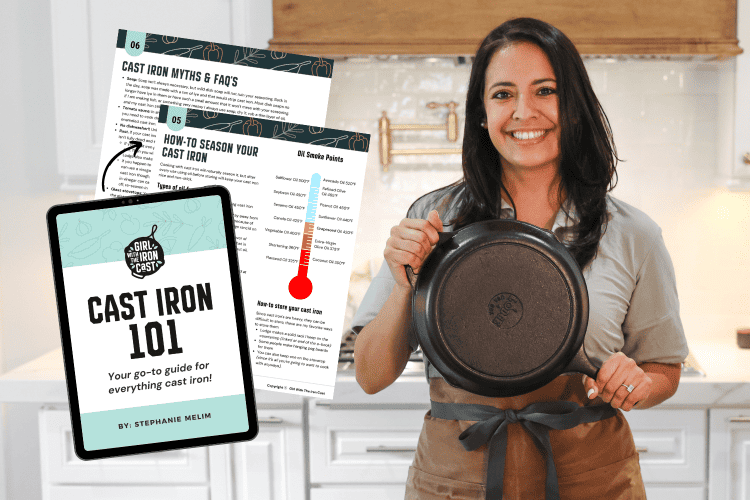
Cast Iron 101 E-Book
In this e-book, I will be talking about everything cast iron! From when you buy your cookware, how to maintain it, to cooking in it, and more!
Did you make this? If you snap a photo, please be sure tag me on Instagram at @girlwiththeironcast or hashtag #girlwiththeironcast so I can see your creations!
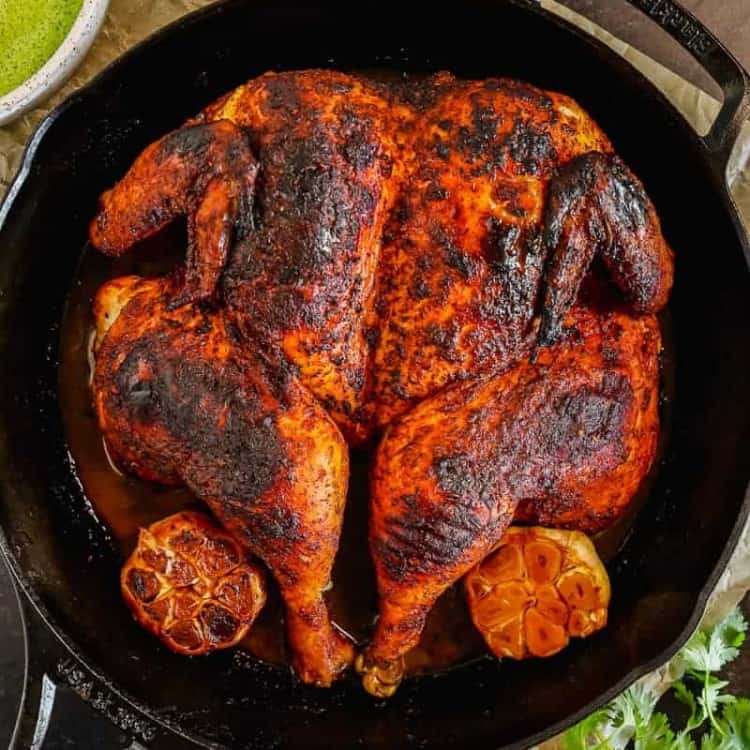
Peruvian Style Roast Chicken with Aji Verde (Green Sauce)
Ingredients
Peruvian Chicken
- 4 pounds whole chicken (innards removed and spatchcocked (see notes))
- 1/4 cup dark brown sugar
- 2 teaspoons chili powder
- 1 1/2 teaspoons smoked paprika
- 1 teaspoon ground cumin
- 4 cloves garlic (finely minced or pressed through garlic press)
- 1/2 teaspoon ground ginger
- 2 tablespoons low sodium soy sauce
- 1 tablespoon lime juice
- 1 teaspoons lime zest
- 1 tablespoon olive oil
- 1 teaspoons Kosher salt
- 2 heads garlic (1/4 of top sliced off to expose tops of cloves)
Aji Verde (Green Sauce)
- 2 cups cilantro
- 1/4 cup mayo
- 1/4 cup crumbled cotija cheese
- 1 large or 2 medium jalapeños (seeds removed for less heat)
- 4 cloves garlic
- 2 tablespoons avocado oil or olive oil
- Juice of 1 lime
- 1/4 teaspoons Kosher salt
Email this Recipe!
Email this recipe to yourself to save for later.
By submitting this form, you agree to receive emails from Girl with the Iron Cast.
Equipment
Before You Begin! If you make this, please leave a review and rating letting us know how you liked this recipe! This helps our business thrive & continue providing free recipes.
Instructions
- Prep and spatchcock whole chicken (see notes for how-to prep and spatchcock chicken). Place on half baking sheet.
- In a small bowl, mix all marinade ingredients together until fully combined: brown sugar, chili powder, smoked paprika, ground cumin, pressed garlic, ground ginger, soy sauce, lime juice, lime zest, olive oil, and kosher salt.
- Using a marinade brush, brush whole surface of the chicken, ensuring to get the nooks and crannies. Place in refrigerator and allow to marinate overnight for maximum flavor.
- Preheat oven to 425F
- You can roast the chicken on a sheet pan, but I prefer roasting in my cast iron pan to keep the heat even throughout the skillet. Take two heads of garlic and cut the top 1/4 off to expose the bulbs. Tuck these cut side down next to the legs.
- Roast chicken until thickest part of breast and leg reach 165F. Depending on the size of your bird, should take about 45 minutes. If the skin begins charring too much for your liking, you can tent with foil.
- While the chicken roasts, prepare the aji verde (green sauce). Using a food processor or an immersion blender, blend cilantro, peppers, lime juice, garlic, cotija cheese, mayo, and salt. Taste and adjust seasoning if necessary.
- To remove the legs from the chicken, lift by the bone to expose where the leg meats the breast and cut through where thigh meets the breast. To separate leg from thigh, cut through joint. Slice breast down the middle and you can additionally cut into slices to serve. Rest of bones can be discarded in ziplock bag and frozen until trash day.
- Serve with drizzling aji verde green sauce over the top or on the side as a dipping sauce and with roasted garlic cloves to spread on every bite.
Notes
Prepping the chicken
- When handling chicken, I like to wear gloves and also set up a sanitary station with a bowl, sheet pan, and a gallon ziplock bag for discard. To prep the chicken, first you need to remove the bag from the cavity and the pouch that is usually located on top of the neck. I typically place in a ziplock, then freeze until it’s garbage day.
- I place colander inside of a bowl to catch all the juices while I dry the chicken with paper towels. You want the entire chicken dried, inside the cavity and out. (I add the paper towels to my discard ziplock, ensuring not to touch anything else without gloves or washing my hands).
How-to spatchcock a chicken

- Locate the back bone of the chicken.
- Using sharp poultry shears (or strong scissors), begin cutting to one side of the back bone. There are small bones you will be cutting though, so ensure the scissors are strong enough.
- Repeat on the other side of the back bone and then place the back bone in the ziplock discard bag.
- Next, locate the inside of the breast bone. Careful to not cut the skin, cut through the cartilage of the breast bone. This will assist you in flattening the breast, if you are strong enough, you can skip this step.
- Flip the chicken over and place the heel of your hand in the middle of the breast. Press down hard until the breast is fully flattened.
- Rotate the legs inward. You can also tuck the wings into the armpits, so the tips do not burn when roasting.
Thermometers
- Thermometers are your best friend when roasting chicken, it ensures not only that the chicken is fully cooked through, but that you are not over cooking the chicken.
- There are different types of thermometers you can use, my favorite is this oven safe probe so you do not have to keep removing from the oven to check the temperature.
Aji Verde (green sauce)
- Store in an airtight container in refrigerator for up to 4 days. If it begins to separate, re-blend or whisk. Great on steak and seafood as well!




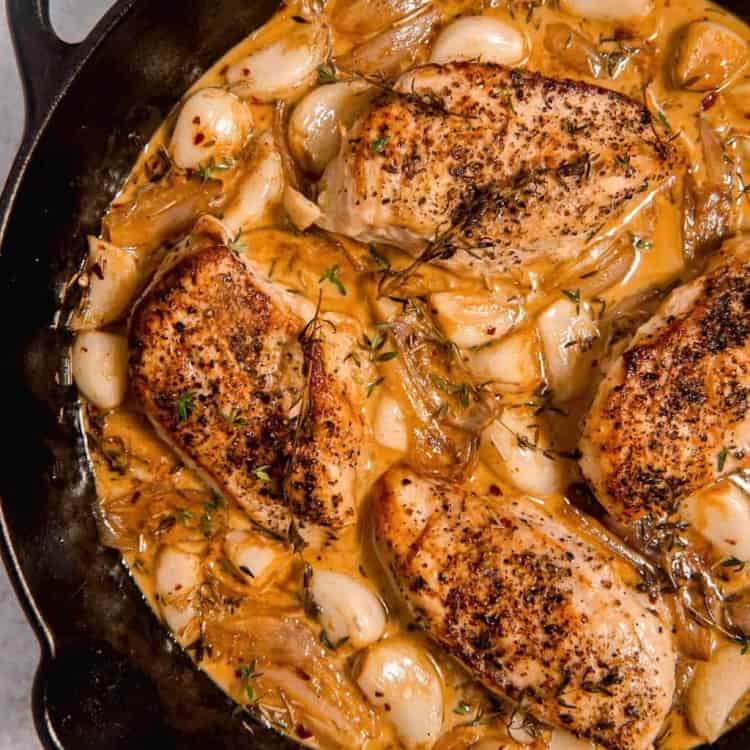


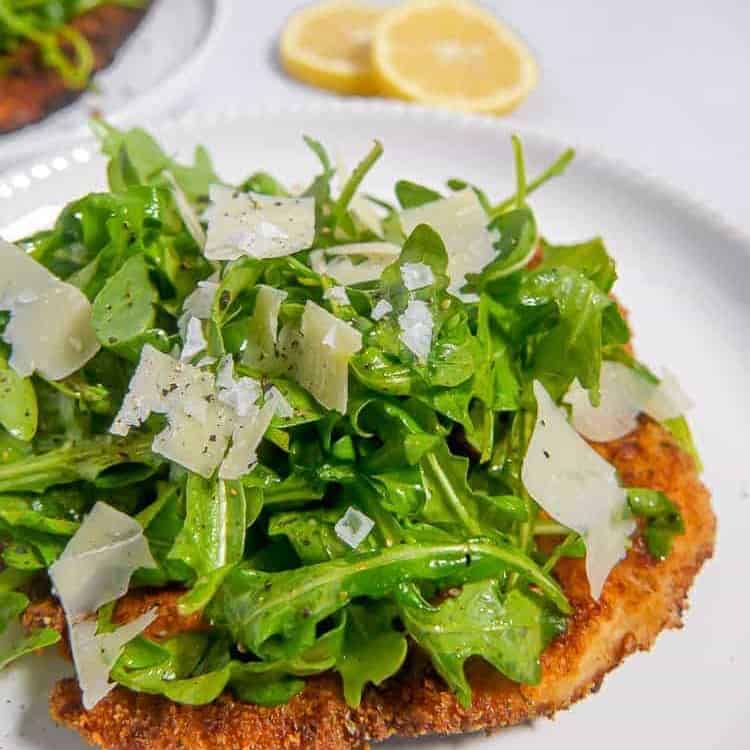
Absolutely delicious recipe!! Will certainly make again. Thank you for sharing it was so good.
Blew my husband’s mind. He said it was the best chicken he ever had and I agree!
Wow what a compliment Rachel! So glad you both enjoyed it, cheers!
Delicious! The chicken was so tender. The sauce was perfect. We had tostones with it. I will definitely make this again.
I’m so glad you enjoyed the recipe Alisa! Thanks for making it.
This is SOOOO good ! my new favorite way to cook chicken.. soo tasty.
I’m so glad you enjoyed the recipe Nikki!
I’m confused. Aren’t there supposed to be aji peppers or paste in the aji verde? Are the jalapeños instead of?
This is an aji style green sauce, not traditional. There is a section in the recipe post discussing the traditional ingredients and why my twist on the recipe uses jalapeños instead of aji chiles. If you are able to find them, substitute it for the jalapeños.
Well done recipe. Good instructions. I will be looking for more tasty things here.